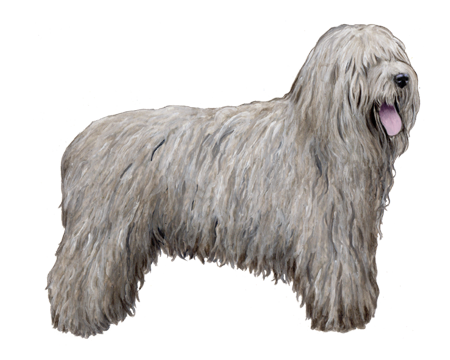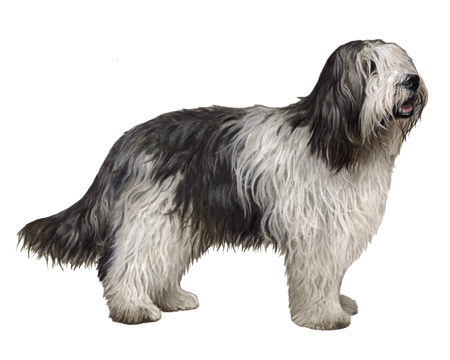
Great Pyrenees
Great Pyrenees are powerful working dogs devoted to their flocks and families. These big bundles of energy also have patient, calm demeanors that endear them to their owners.
Interested in discovering if your dog is a Great Pyrenees?
Check out Wisdom Panel's DNA tests.

Great Pyrenees Traits
General Appearance
Great Pyrenees capture attention for their overall size and structure. These are large dogs with muscular bodies, smooth, agile movements, and impressive coordination that conveys power and elegance.
Coat and Coloring
Great Pyrenees have weather-resistant double coats. The wooly undercoats are dense and fine. The outer coats are flat, thick, and coarse with straight or slightly undulating hair. The hair on their faces and ears is shorter and more profuse around the neck and shoulders, forming a ruff (that is more pronounced in males). Feathering along the back of the front legs and back of the thighs creates a pantaloon effect, and longer hair on the tail forms a plume.
Great Pyrenees are white or white with gray, badger, reddish-brown, or tan markings. They may also have white or shaded undercoats.
Distinctive Physical Traits
Great Pyrenees are majestic dogs with strong bodies; broad chests; muscular shoulders and thighs; and rounded, close-cupped, feet with well-padded toes. Their tails are well-plumed and carried low. Great Pyrenees have wedge-shaped heads; small-to-medium-sized, V-shaped ears with rounded tips; and medium-sized, almond-shaped, dark brown eyes.
Great Pyrenees Temperament
Great Pyrenees are confident and fearless. In their work, these dogs are territorial and protective of their flocks and families when needed. They can be strong-willed, independent, and reserved dogs. Great Pyrenees also have a quiet, composed, gentle, affectionate demeanor. They are patient, tolerant, and mellow companions, which makes them excellent family dogs.
Thanks to their calm demeanors and social natures, Great Pyrenees often work as therapy dogs and are renowned for their skill nurturing small, young, or sick animals.


Great Pyrenees History
The Great Pyrenees is an ancient breed with origins that might date back as far as 1800 B.C. This breed, whose ancestors include the Maremma Sheepdog and Anatolian Shepherd, is known as the Pyrenean Mountain Dog in Europe. They were brought to the Pyrenees Mountains between France and Spain and put to work as herding dogs.
The dogs navigated wide swaths of rugged terrain and spent long periods in the elements to guard their flocks. Great Pyrenees excelled in their work, chasing off wolves, bears, and other predators. They earned reputations as legendary livestock guardians. When the dogs were off the clock, they often bunked with their shepherds, guarding their homes.
During the 1600s, Louis XIV declared these gentle and affectionate souls to be the Royal Dog of France. Despite the honor—and their incredible skill as working dogs—the population of Great Pyrenees was in decline. Dedicated breeders combed the mountains in search of Great Pyrenees, bringing back the best examples of the breed to rebuild their numbers. Their efforts paid off, and they established the first breed standard in 1927. A few years later, the first Great Pyrenees arrived in America, where it remains a popular companion and working dog.
Great Pyrenees Care
Nutrition
Great Pyrenees eat a small amount of food for their size. Still, it's important to feed them a high-quality dog food appropriate for their life stage (e.g., puppy, adult, senior).
Great Pyrenees are susceptible to bloat. Multiple small meals rather than fewer, larger meals can help reduce the risk. Be careful not to overfeed Great Pyrenees. Portion out their food with a measuring cup and limit treats to no more than 10% of their daily calories.
Grooming
Great Pyrenees have dirt-and tangle-resistant coats that require minimal grooming. Brush them at least once per week—more often during seasonal shedding—to remove cast-off hair. A pin brush or slicker brush can help reduce shedding.
Great Pyrenees also require regular ear cleanings, nail trims, and a dental care routine that includes at-home teeth-brushing and professional cleanings. Start these grooming essentials when Great Pyrenees are puppies to ensure they are part of a lifelong habit.
Exercise
When it comes to fending off predators, Great Pyrenees are tireless. But these big dogs spend most of their time surveying their surroundings without exerting much energy. Great Pyrenees have moderate exercise needs and appreciate walks or opportunities to sniff around a fenced yard. Dog sports such as cart-pulling, obedience trials, and agility provide Great Pyrenees opportunities to exercise their minds and bodies.
Training
It can be a challenge to train Great Pyrenees. These are intelligent dogs, but that often means commands like "sit" and "come" that owners deem essential might not seem that important to the Great Pyrenees. The breed will either outright ignore commands or respond at a glacial pace to indicate their boredom. A consistent training routine that incorporates positive reinforcement and rewards could help convince Great Pyrenees to get with the training program.
Socialization is important, too. Starting when Great Pyrenees are puppies, introduce them to new people, pets, and places to help them become well-mannered, well-adjusted dogs.

Great Pyrenees Genetic Health Conditions
-
Canine Multifocal Retinopathy 1
Canine Multifocal Retinopathy 1 (CMR1) is an eye disorder that can cause retinal decay which may impact vision, but very rarely results in blindness.
-
Glanzmann Thrombasthenia Type I (Discovered in Great Pyrenees)
Glanzmann Thrombasthenia (GT) Type I is a blood disorder characterized by poor blood platelet aggregation. Platelet in the blood are needed to help start clot formation, so as a result of this disorder bleeding may be prolonged.
Knowing if your Great Pyrenees is a carrier or at-risk for these conditions can help you and your veterinarian plan for your pup’s lifelong care. With Wisdom Panel™ Premium, you can get results for over 200 genetic health tests.
Breed Group
Herding
The herding group is a diverse category. These highly intelligent breeds were developed to guard and control the movement of livestock.


































































